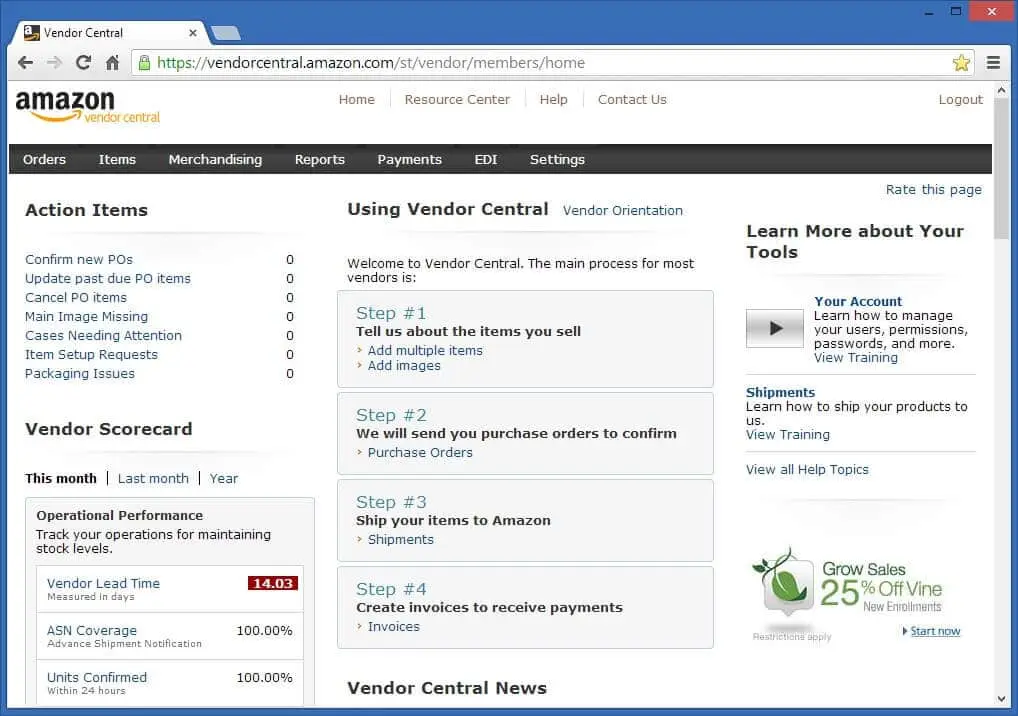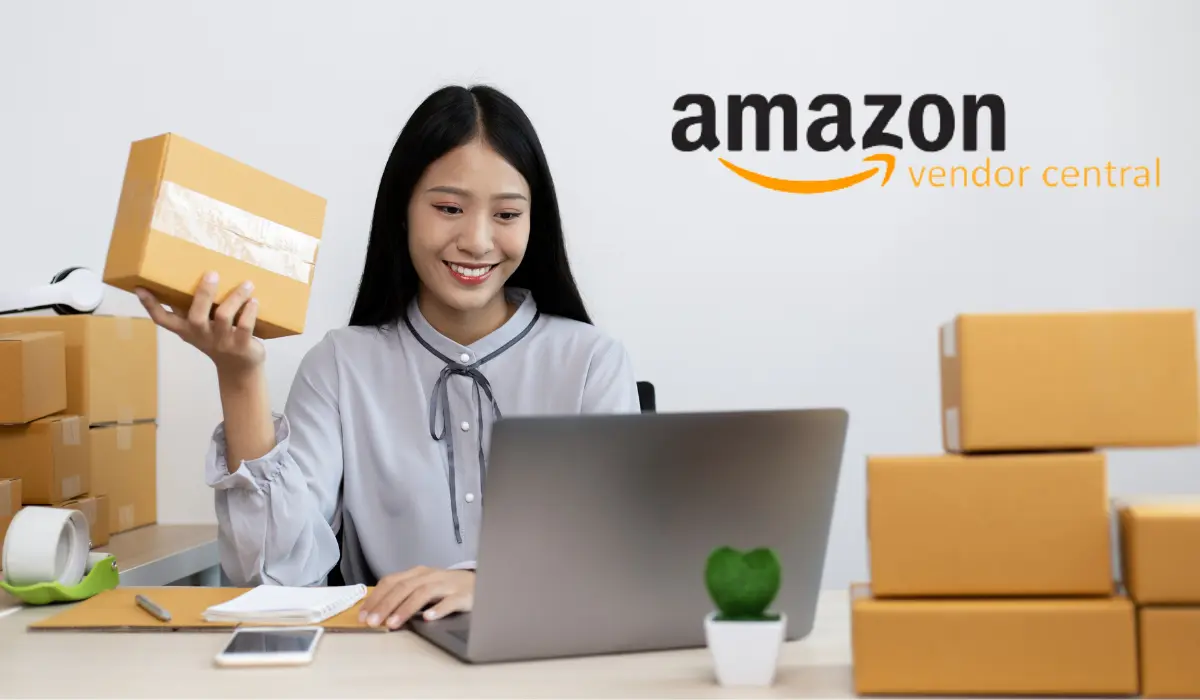Amazon is a preferred platform for over a million small businesses in the United States to sell their products, and this is attributed to various advantages offered by the e-commerce giant.
Signing up as an Amazon seller isn’t the only way to make money on one of the largest eCommerce platforms, which is Amazon. You have a few more options at your disposal.
For instance, you can consider selling straight to Amazon rather than becoming a seller; in return, Amazon will market your products. Seems like a great plan?
This is quite different from being an “Amazon Seller” and is referred to as an “Amazon Vendor.” So let’s examine what it is and whether it is worthwhile.
What Is Amazon Vendor Central?
Amazon Vendor Central enables transactions amongst independent sellers and Amazon. It is one of the critical components of Amazon’s financial success, particularly in the book-selling sector. Independent vendors and sellers are welcomed in this program (with exclusive distribution rights or liberty to titles).

A vendor can sell directly to Amazon through this portal, and Amazon will then sell the products to its customers. In contrast, an individual seller uses Amazon’s platform to sell directly to customers, and Amazon receives a fixed price for this.
Vendor Central, which functions more like a web portal, enables a vendor to swiftly and effectively meet the needs of its clients. However, only vendors who have received an invitation from Amazon can transact business with Amazon using Vendor Central.
Once it is set up, an Amazon vendor is paid monthly at wholesale rates. A customer orders directly from Amazon and pays the appropriate amount. After that, Amazon ships the goods. However, if a customer purchases a product directly from the seller, the product page for that item clearly states that it is “In Stock, Shipped, and Sold by Amazon.com.”
See Also: Tips for Landing Your Product on the First Page of Amazon
Amazon Vendor Central – Key Features
- Invite only
- Brands selling products on Amazon
- The marketplace manages retail prices.
- Amazon handles fulfillment
- Numerous advertising choices via Amazon
- Traditional sales methods
- A+ content: Access to further interactive and graphic content
How to Get into Amazon Vendor Central?
You cannot just apply to sell on Vendor Central because it is an invitation-only platform.
Why would the marketplace invite any business to sell on Vendor Central when millions of items exist already? Well, new products are continually being developed, and the platform has a poor selection of already-established brands. So the goal of Amazon’s ‘Vendor Central’ recruitment teams, located all around the world, is to find new brands and merchandise to offer.
Many different kinds of businesses receive invitations from the marketplace to use Vendor Central, including:
- Established businesses with strong demand from Amazon customers.
- Exhibitors with appealing products at trade exhibitions and fairs.
- Amazon sellers doing incredibly well with their products.
Normally, the joining process starts with an email from Amazon expressing interest in selling your goods. You would ideally communicate with an Amazon vendor management expert. Once you inform Amazon of your interest in becoming a vendor, they will provide a detailed explanation of how Vendor Central works and present their terms for engagement.
On these parameters, not much negotiation usually takes place. In most cases, the marketplace will present you with an offer you can accept or reject. However, if you represent a significant, well-known brand or have a vendor manager assigned, there could be more room for negotiation.
Once the conditions have been agreed upon, Amazon will set up a Vendor Central account and send you an invitation to sign up. After that, you may start giving marketplace information about your products and prices. If at any stage, you find difficulty in becoming an Amazon vendor, you can seek the help of professional Amazon vendor central consulting services.
Amazon Vendor Central: Pricing, Tax, & Additional Fees
You could believe that since Amazon is purchasing your goods, Amazon Vendor Central management won’t cost you anything.
You will have to pay the money eventually, though.
As a vendor, you will be charged when Amazon provides:
- Campaign execution with Amazon Marketing Services
- Running advertisements on Amazon Media Group
- For stock forwarding
- To make use of their internal resources
- To use Premium Vendor Services
Since the marketplace uses wholesale pricing for Vendor Central, it typically charges vendors 4% to 10% to mask marketing and slotting expenses. Amazon may also demand more active account support fees or marketing expenses as soon as the sales improve.
Also Read: Increase Your Sales with These 8 Amazon Advertising Strategies
Additional Fees or Tax
This largely depends on where you intend to sell.
For instance, VAT taxes are required in Amazon Europe. Therefore, regardless of whether the vendor has not made a sale, Amazon is required by EU legislation to levy the relevant VAT tax each month.
The following additional costs should also be taken into account:
- Shipping the inventory to Amazon’s fulfillment centers
- Cost of international return shipping
- Cost of international shipping
- Conversion fees for receiving payment in your country’s currency
- Customer care service fees
- Taxes & Duties
- Cost of listing translation
What All You Can Do in Amazon Vendor Central?
Vendor Central offers a wide range of features as the primary point of contact for suppliers with Amazon.
The following are more crucial ones:
- Orders – Purchase orders are received by vendors, supplying shipment details.
- Sharing Product Information – You can add pictures, change prices, and provide other product-related details.
- Merchandising – Managing product marketing. You can use services like Amazon Vine and A+ Content from here.
- Making Payments – Finding invoices and remittances.
- Advertising – Managing ad campaigns.
- Reporting – Analyzing how your business is performing.
How Is Amazon Vendor Central Different from Amazon Seller Central?
You sell directly to Amazon via Vendor Central. First-party or 1P is another name for Amazon Vendor Central since when a transaction is made to a customer, Amazon makes the sale, not another business using the marketplace.
You enter your wholesale prices and product listings in Amazon Vendor Central, and after that, Amazon gives you a purchase order. For example, they might place a single order for a handful of units or hundreds. For you, Amazon handles consumer sales, order fulfillment, and customer service.
In Amazon seller central, you can sell as a third party. In layperson’s terms, you are conducting direct business with customers on Amazon’s website. You will sell solitary units to customers directly and are in charge of the retail procedure. Therefore, you must ensure you are getting sales, promptly completing orders, and handling customer service difficulties.
| Business Model | Amazon Vendor Central | Amazon Seller Central |
| Distributors | ✔ | |
| Wholesalers | ✔ | |
| Start-ups | ✔ | |
| Small Businesses | ✔ | |
| Giant Brands | ✔ | |
| Resellers | ✔ | |
| Private Labelers | ✔ | |
| Nationwide Brands | ✔ | |
| Manufacturers | ✔ | |
| Low-Value Products | ✔ | |
| High-Value Products | ✔ | |
| Low Touch Products | ✔ | |
| High Touch Products | ✔ |
Top Reasons Why Amazon Vendor Central Is Worthwhile?
1. Customer Trust
When you offer your goods through Vendor Central as a first-party (1P) vendor, consumers will believe that you are selling them on behalf of Amazon. That approved symbol can increase customer confidence in a way that a third-party seller cannot.
2. Expanded Advertising Possibilities
Through Amazon Marketing Services, sellers can generate demand by running keyword (search term) focused ad campaigns that aim to lead more people to Amazon product pages. Amazon Marketing Services are available to both sellers and vendors. However, Vendor Central members have more advanced choices for managing AMS ad campaigns.
3. Uncomplicated Business Model
As a vendor, your main priority is to fill purchase orders, bill customers, and avoid chargebacks (charges for not meeting Amazon requirements).
4. Amazon A+ Content
If you’re selling through Amazon Vendor Central, the marketplace allows you to add enhanced content via Amazon A+ Detail Pages.
5. Other Marketing Tools
You can also use Amazon Vendor Central to engage in promotional programs like Subscribe & Save and Amazon Vine, which sends your goods to top reviewers.
See Also: 10 Amazon PPC Automation and Management Software
Wrapping Up
Despite its challenges, Vendor Central presents rich opportunities for successful Amazon Sellers. Any Vendor may enhance their profits and scale up their business in a reasonably short time with a few minor adjustments to their business plan, the right tools, and the right Amazon vendor central consultant by their side.





